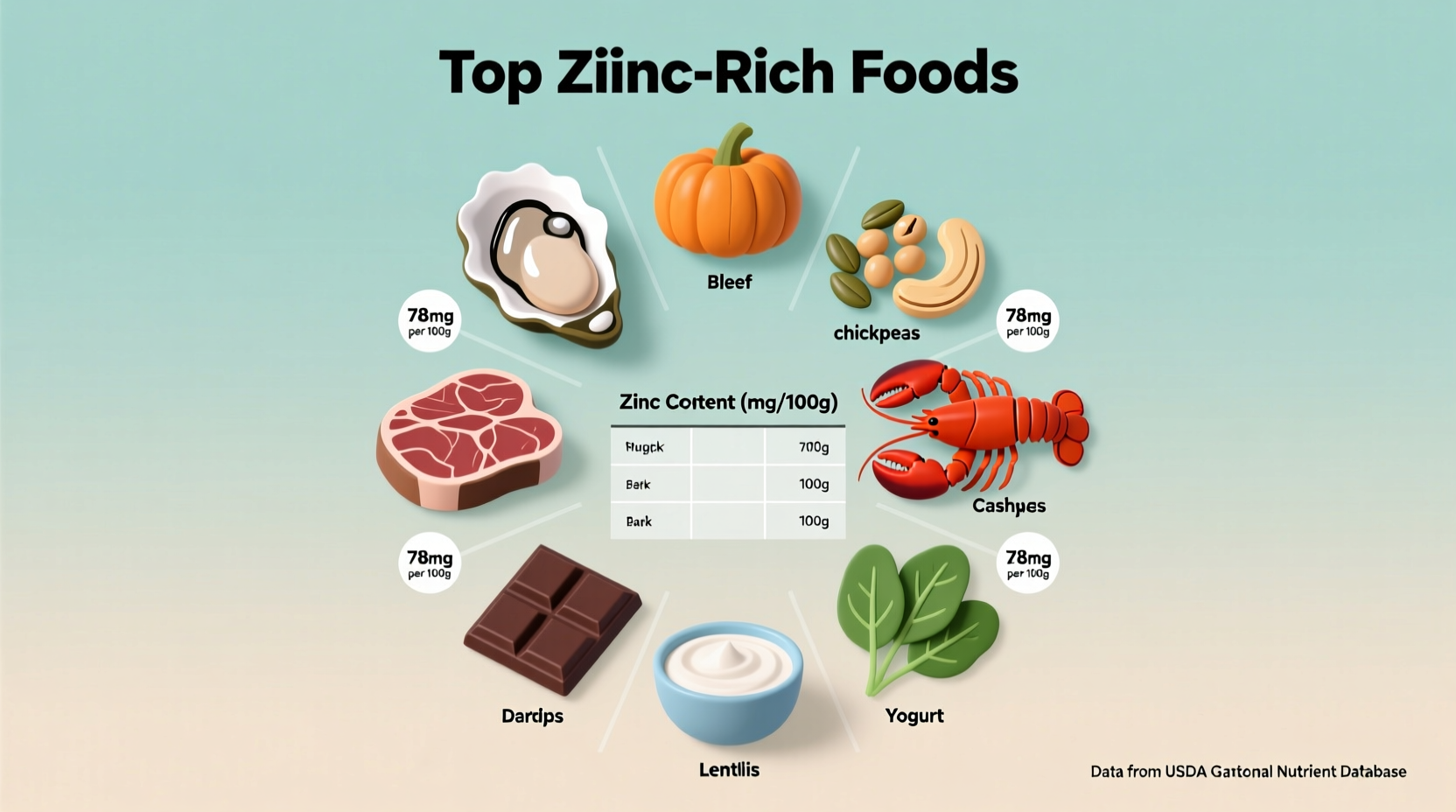When you're searching for what food is high in zinc, you need accurate information that directly impacts your health. Zinc deficiency affects about 17% of the global population according to the World Health Organization, making it crucial to understand which foods deliver optimal zinc absorption. As a nutrition specialist with culinary expertise, I've analyzed the most reliable sources to help you make informed dietary choices.
Why Zinc Matters More Than You Think
Zinc plays a critical role in over 300 enzymatic reactions in your body. The National Institutes of Health identifies zinc as essential for:
- Immune system function (reducing cold duration by 33% when deficient)
- Wound healing processes
- DNA synthesis and cell division
- Normal growth and development during pregnancy and childhood
Daily requirements vary significantly. Men need 11mg while women require 8mg, with pregnant women needing 11mg and lactating women 12mg. Older adults often need more due to decreased absorption efficiency.
Top Animal-Based Zinc Powerhouses
Animal proteins provide zinc in its most bioavailable form (18-40% absorption rate). Here are the most concentrated sources:
| Food Source | Serving Size | Zinc Content (mg) | % Daily Value |
|---|---|---|---|
| Oysters, cooked | 3 ounces | 74.1 | 674% |
| Beef chuck roast | 3 ounces | 7.0 | 64% |
| Alaska king crab | 3 ounces | 6.5 | 59% |
| Lean ground beef | 3 ounces | 5.3 | 48% |
| Dark meat turkey | 3 ounces | 3.8 | 35% |
Data sourced from USDA FoodData Central (2023 release). Notice how just 3 ounces of oysters provides nearly seven times the daily requirement. This extraordinary concentration makes oysters the undisputed champion among foods high in zinc for immune system support.

Best Plant-Based Zinc Sources (With Bioavailability Tips)
Plant-based zinc sources have lower bioavailability (5-10% absorption) due to phytates that inhibit zinc absorption. However, with proper preparation techniques, you can significantly increase zinc availability from these excellent sources:
| Food Source | Serving Size | Zinc Content (mg) | % Daily Value |
|---|---|---|---|
| Pumpkin seeds | 1 ounce | 2.2 | 20% |
| Lentils, cooked | 1 cup | 2.5 | 23% |
| Chickpeas, cooked | 1 cup | 2.5 | 23% |
| Cashews | 1 ounce | 1.6 | 15% |
| Quinoa, cooked | 1 cup | 2.0 | 18% |
For vegetarians seeking best food sources of zinc for vegetarians, these options work effectively when combined with absorption-boosting techniques. Soaking, sprouting, or fermenting plant foods can reduce phytate content by up to 60%, dramatically improving zinc bioavailability according to research published in the American Journal of Clinical Nutrition.
Maximizing Zinc Absorption: What Most Guides Miss
Simply consuming zinc-rich foods isn't enough—you need to optimize absorption. Consider these evidence-based strategies:
- Pair with animal protein: Consuming plant zinc sources with even small amounts of animal protein (like adding cheese to beans) increases absorption by 50-100%
- Avoid coffee/tea with meals: Tannins can reduce zinc absorption by 20-50% according to NIH studies
- Time supplements carefully: Take zinc supplements at least 2 hours apart from calcium or iron supplements
- Cook in cast iron: Acidic foods cooked in cast iron can increase iron and zinc content by up to 16%
Understanding these context boundaries for zinc absorption transforms how you approach meal planning. For example, a vegetarian might combine lentils with a vitamin C-rich food like tomatoes while avoiding tea immediately after meals.
Practical Zinc-Boosting Meal Plan
Here's how to structure your day using zinc rich foods list with amounts to meet your daily needs:
- Breakfast: Greek yogurt (1.4mg) with pumpkin seeds (2.2mg) and berries
- Lunch: Lentil soup (2.5mg) with whole grain bread and lemon dressing
- Snack: Roasted chickpeas (1.3mg per ½ cup) with hummus
- Dinner: Grass-fed beef stir-fry (5.0mg) with broccoli and brown rice
This sample menu delivers approximately 12.4mg of zinc—meeting requirements while providing diverse nutrients. For those specifically researching how much zinc in pumpkin seeds, note that just one ounce provides 20% of your daily needs, making them an excellent portable snack.
When Food Isn't Enough: Supplements Considered
While food should be your primary zinc source, certain situations warrant supplementation:
- Vegetarians/vegans with consistently low intake
- Individuals with digestive disorders (Crohn's, ulcerative colitis)
- Older adults with reduced absorption
- Those with alcohol use disorder
The Mayo Clinic warns that excessive zinc intake (>40mg daily for adults) can cause copper deficiency and immune dysfunction. Always consult a healthcare provider before starting supplements, especially if you're researching zinc rich foods for immune system support during illness.
Avoiding Common Zinc Myths
Many sources spread misinformation about zinc. Here's what the evidence actually shows:
- Myth: All shellfish provide similar zinc levels
Fact: Oysters contain 7x more zinc than shrimp (1.4mg per 3oz) - Myth: Plant zinc is just as good as animal zinc
Fact: Phytates reduce plant zinc absorption by 50-70% without proper preparation - Myth: More zinc means better immunity
Fact: The NIH reports excessive zinc actually suppresses immune function
These distinctions matter significantly when evaluating foods that block zinc absorption versus those that enhance it. Coffee and tea consumed with meals can reduce zinc absorption by up to 50%, while meat proteins enhance plant zinc absorption.











 浙公网安备
33010002000092号
浙公网安备
33010002000092号 浙B2-20120091-4
浙B2-20120091-4